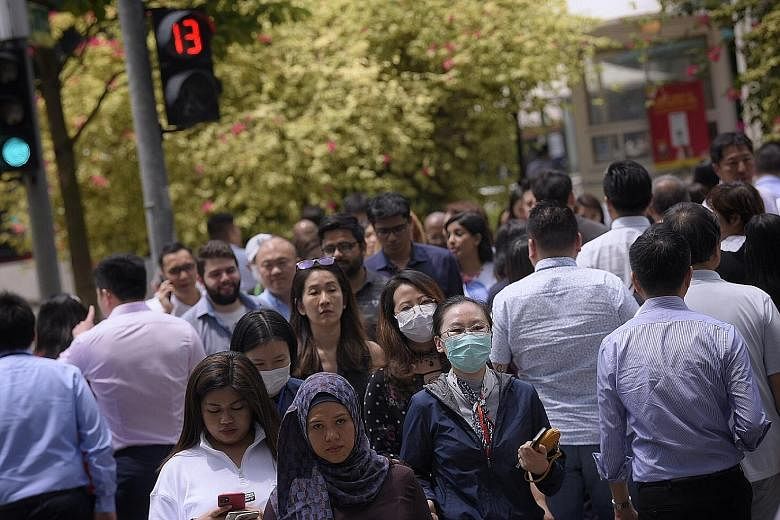Even before the coronavirus outbreak, employers were more cautious about hiring last year amid economic uncertainties.
As a result, the seasonally adjusted ratio of job vacancies to unemployed persons fell to 0.84 in December, down from 1.09 a year earlier, according to the latest figures released yesterday by the Ministry of Manpower (MOM).
Economists said the picture this year is likely to be more grim, given that the outlook has soured as the coronavirus spreads worldwide.
Unemployment and retrenchments are likely to worsen this year, they added.
Manpower Minister Josephine Teo said Singapore has to brace itself for a more bumpy road ahead.
This is why the Government's priority is to stem job losses, she told reporters at an event on Tuesday.
"In the medium to longer term, if you look at what Singapore will be in the future... the opportunities are still here," she said.
The reasons she cited are that the labour market in the last few years was still relatively tight and the working-age population "will not expand by so much".
"But we have to be quite realistic," she added. "For the next few months the priority has to be to help the companies settle down."
If they survive the current upheaval, "there's a chance for them to start hiring in more significant numbers", she said.
Still, the proportion of residents - Singaporeans and permanent residents - who got new jobs last year within six months of being retrenched edged up to 64 per cent, from 63 per cent in 2018.
Similarly, the long-term unemployment rate for residents remained unchanged at 0.7 per cent last year. This refers to the share of the resident labour force unemployed for at least 25 weeks.
But the quarterly rate, adjusted for seasonal variations, rose in the second half of the year to 0.9 per cent in December, the highest level in at least six years.
Overall, the labour market did better than expected last year, Mrs Teo said.
She also reiterated that unemployment remained within the low range of recent years, employment of locals grew slightly faster than in 2018, and the level of retrenchments stayed stable, even dipping for professionals, managers, executives and technicians (PMETs).
Local employment grew by 28,300 last year, up from 27,400 in the previous year, yesterday's data showed.
This is a reversal of the preliminary data, released in January, which showed local employment growth declining to 26,500.
Foreign employment, excluding maids, grew by 28,700, up from 10,900, with the difference coming mainly from more construction workers being hired.
MOM said yesterday that the labour market outlook is expected to be subdued as the overall economic growth is expected to moderate. It grew by 0.7 per cent last yer.
Economists said that unemployment and retrenchments will likely worsen this year, especially in such sectors as tourism and hospitality.
"The Covid-19 outbreak has thrown a big spanner in the works, derailing the already tepid recovery expected for this year," said DBS Bank senior economist Irvin Seah.
"The downside risk for the labour market is inevitable especially because of the impact of the virus on labour-intensive service industries."
Maybank Kim Eng senior economist Chua Hak Bin said: "The sharp economic contraction is stressing sectors beyond just hospitality and travel, and recruitment and the whole hiring process have probably been frozen until normal office life resumes."
The outbreak makes it hard to set up interviews and meetings, he added.
But OCBC Bank chief economist Selena Ling sees a silver lining in the job support package announced in the Budget last month, with more help on the way in a second support package that Deputy Prime Minister Heng Swee Keat said on Wednesday is being worked out.
Ms Ling said: "I don't expect a big spike in overall unemployment rates because there is a big focus on protecting local jobs, and the foreign manpower policy stance is still tight."
But wage growth will probably moderate, she added.
Private-sector economists see the Singapore economy contracting by 0.8 per cent in the first quarter of this year owing to the coronavirus, according to a quarterly survey released on Wednesday.
The survey by the Monetary Authority of Singapore also showed economists slashing their forecast for full-year growth to 0.6 per cent.
Last month, the Trade and Industry Ministry had downgraded its growth forecast for the year to between minus 0.5 per cent and 1.5 per cent, indicating a possible recession.
Growth is expected to come in around 0.5 per cent, the mid-point of the forecast range.
Even so, MOM noted there are pockets of relative strength in the economy that will continue to provide job opportunities.
It pointed to the construction sector, where demand has rebounded since 2018, and the information and communications sector, which is supported by sustained demand from businesses for IT solutions as they continue to restructure and transform.
The labour market report yesterday gave updates and more details on preliminary statistics released in January.
For example, PMETs made up 73.6 per cent of the 10,690 workers asked to go last year.
By age, the most affected workers last year - 72.3 per cent - were those aged 40 and older.


